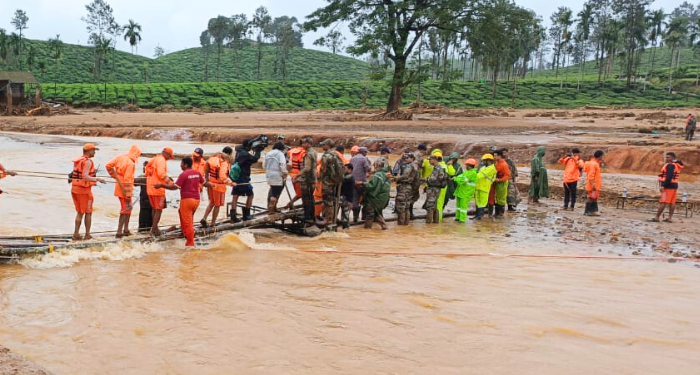Wayanad, a hilly district in north Kerala, came face to face with the wrath of nature in the early hours of 30 July as massive landslides of unprecedented scale buried hundreds in their sleep. Experts are of the view that it was a disaster in the waiting as a fatal cocktail of massive deforestation, relentless mining and climate change had already endangered this district located in the Western Ghats. A landslide atlas published last year by the Indian Space Research Organisation’s National Remote Sensing Centre has pointed out that Kerala is home to 10 out of the country’s 30 most landslide-prone districts, with Wayanad positioned at 13th.
The atlas further revealed that about 0.09 million sq. km in the Western Ghats and the Konkan hills— spanning Tamil Nadu, Kerala, Karnataka, Goa, and Maharashtra—are susceptible to landslides. Another study published in the International Journal of Environmental Research and Public Health in 2022 on the declining forest cover in Wayanad revealed that 62 per cent of the district’s forests vanished between 1950 and 2018. Scientists have indicated that climate change is likely to heighten the risk of landslides in the Western Ghats, recognised as one of the world’s eight “hottest hotspots” of biological diversity. The landslides also highlight how warnings from the Western Ghats Ecology Expert Panel led by renowned ecologist Madhav Gadgil were routinely ignored by the authorities. In 2011, the panel submitted its findings to the Centre, suggesting that the entire mountain range be classified as an ecologically sensitive area, divided into zones based on their ecological vulnerability. Among its recommendations was a blanket ban on mining, quarrying, new thermal power plants, hydropower projects, and large-scale wind energy development in the most sensitive area, referred to as zone 1.
However, none of these recommendations made 14 years ago were implemented in the face of stiff resistance from successive state governments and other stakeholders. Wayanad-like tragedies have become all too common in the eco-fragile regions in north, northeast and south India. Come monsoon, and we are flooded with news of landslides, cloudbursts and flash floods claiming lives and properties in the states like Uttarakhand, Himachal Pradesh and Sikkim and other mountainous regions across the country. In the light of monsoon rains becoming all the more unpredictable, experts have called for a reliable early warning system along with a structured evacuation plan in vulnerable hilly regions to save precious lives from such recurring tragedies. Forget heeding to such sensible advice, the governments, Centre and states, most often act in ways that are detrimental to the environment.
In Uttarakhand, the government went ahead with the Char Dham Project connecting the Himalayan shrines of Badrinath, Kedarnath, Gangotri and Yamunotri despite experts flagging the risks of building a highway in the fragile land. And the results are for everyone to see — land subsidence in Joshimath, frequent landslides in various parts of the state, the Uttarkashi tunnel collapse incident, and the list goes on. Unconcerned governments in connivance with greedy corporates have damaged our natural environment beyond redemption, all in the name of development.







































